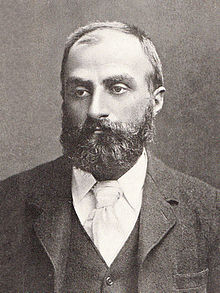William Speirs Bruce
William Speirs Bruce (born August 1, 1867 in London , † October 28, 1921 in Edinburgh ) was a London-born polar explorer and oceanographer of Scottish descent. He led the Scottish National Antarctic Expedition from 1902 to 1904, which had the Weddell Sea as its destination.
1892-93 led a whaling trip , the Dundee Whaling Expedition , to the Falkland Islands Bruce for the first time in the Antarctic waters . Participants in this expedition also included his friend and artist William Gordon Burn-Murdoch .
In 1901 Bruce Robert Falcon was to accompany Scott on his discovery expedition to Antarctica. He refused, however, because he was preparing his own expedition, the Scottish National Antarctic Expedition . On November 2, 1902, he sailed south with the Scotia . He reached the mainland but found no suitable place to hibernate, whereupon he drove north again and spent the winter in the South Orkney Islands and examined the fauna there .
In January 1904 he discovered Coatsland on the eastern coast of the Weddell Sea . He named the region after James Coats Jr. and Major Andrew Coats , who were the main supporters of the expedition. On July 15, 1904, the ship arrived in Northern Ireland after returning home . This expedition was the first that was able to produce moving images of the Antarctic coast, and the first use of bagpipes in the Antarctic region was documented by this expedition. Because of the first film and sound documents from Antarctica, Bruce is also considered a pioneer of documentary film .
On Laurie Island , Bruce established the Omond House weather station , which was later taken over by Argentina and which is still the longest continuously operating meteorological station in Antarctica.
Bruce further research devoted himself mainly to Spitzbergen , moreover he directed from 1915 to 1916 a whaling station in the Seychelles . However, since Bruce hated the tropical climate , he retired to Scotland. There he died in 1921 after a long and serious illness. His ashes were distributed in the Southern Ocean.
A number of geographic objects in Antarctica are named after Bruce. Among them is Bruce Point , a rock needle in East Antarctic Victoria Land, the Bruce Plateau and Bruce Island in West Antarctic Graham Land and Bruce Nunatak , an island in the Weddell Sea.
Works (selection)
- Polar exploration (Home university library of modern knowledge; 8). Williams & Norgate , London 1911
- The voyage of the "Scotia". Being the record of a voyage of exploration in Antarctic seas . Blackwood, Edinburgh 1906 (with Robert C. Mossman and James H. Pirie)
Movie
- On the trail of great explorers - William Speir's Bruce documentary series, GB, 2011. Running time: 50 minutes Original title: The Last Explorers. With: Neil Oliver, Simon Tait u. a.
literature
- Robert N. Brown: A naturalist at the poles. The life, work and voyages of Dr. WS Bruce, the polar explorer . Seely, London 1923
- Innes M. Keighren: A Scot The Soul of The Antarctic. The Reception and Commemoration of William Speirs Bruce (PDF; 3.95 MB), MSc Thesis University Edinburgh 2003.
Web links
| personal data | |
|---|---|
| SURNAME | Bruce, William Speirs |
| BRIEF DESCRIPTION | Scottish polar explorer and oceanographer |
| DATE OF BIRTH | August 1, 1867 |
| PLACE OF BIRTH | London |
| DATE OF DEATH | October 28, 1921 |
| Place of death | Edinburgh |
